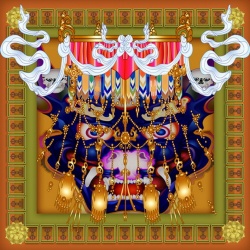Visualisation Meditation (Deity Practice)
Explores the role of visualisation in traditional practices, with a brief summary of the main traditional deity practices - Chenrezig, Medicine Buddha, Vajrasattva, Shakyamuni & Tara.
Visualisation, as a format for meditation, is an essential aspect in the practices of Tibetan Buddhism. Many of the structure visualisations used are elaborate and complex. Most beginning Buddhists, and even many non-Buddhists, are familiar with the ritual artwork of mandalas. Whether or not they understand the symbolic language to access the mandala as a visual meditational device, mandalas can be appreciated for their beauty of form. Sand mandalas, through the direct efforts of HH the Dalai Lama, have achieved a degree of worldwide recognition.
Another format of visualisation meditation has proven more difficult, in general, for Westerners to understand fully or accept. Deity yoga as it is termed by Tibetan practioners involves the visualisation of single or multiple deities, with specific attributes, colours, symbols, gestures and mantras. All of these variables are structured into a format of either a sadhana or a more extensive puja. The word "deity" itself tends to conjure up one of two images in the Western mind: an all powerful theistic creator being, or a supernatural character from an archaic and primitive system of superstitions.
Neither of these viewpoints holds true for the Buddhist mind. The "deities" involved are named symbols of aspects of the enlightened Buddha that are given a visual form to meditate on. Worship is neither incorporate, nor implied.
In visualisation meditation we use visualisations of the Buddha or an aspect of the Buddha in order to create the causes for our own enlightment, and we recite mantras to protect the mind from our attachment, anger, ignorance and so forth. While we recite the mantra, we think and visualise in a beneficial way to develop constructive habits in the mind.
Chenrezig The benefits of reciting the Compassion Buddha mantra are infinite, like the limitless sky. Compassion is the wish to bring about the happiness of others by freeing them from suffering. By visualising Chenrezig and reciting the mantra, we awaken and develop the potential for compassion and the wisdom to understand suffering and deal with it skilfully.
Medicine Buddha This can be done for anyone who is sick, dying or even who has already died. Medicine Buddha visualisation is not only for healing. In addition, it is very powerful for success and for solving any problems.‖ Lama Zopa Rinpoche
Vajrasattva There is no negativity that cannot be purified. It is our mind (and on the basis of that our actions) that creates the negativity and it is our mind that can purify and transform the results of our thoughts and actions. In the Vajrasattva visualisation we purify our negative actions by applying the four opponent powers: refuge, regret, recitation and resolve
Shakyamuni Buddha Through this we learn to identify with our innate wisdom and compassion – our own Buddha nature. A Buddha is a fully awakened being who has completely transformed their mind. By visualising the Buddha and reciting the mantra we create the causes to become a Buddha ourselves.
Tara We experience so many inner obstacles to the development of our mind, and in turn they create many outer obstacles. For the success of our Dharma practice, of our actualising the graduated path to enlightenment, we must rely upon a special deity, or Buddha, such as Tara. All the actions of the Buddhas have manifested in this female aspect of Buddha, Tara the Liberator, in order to help living beings to successfully accomplish both temporal and ultimate happiness.

